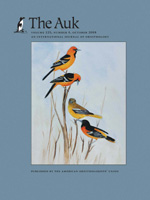Populations occupying "sink" habitats can persist if productive local subpopulations exist, if immigrants rescue the population, or if both processes occur. We tested these hypotheses by combining capture–mark–recapture data and recruit origin assignments obtained from feather stable-isotope values from a local Mallard (Anas platyrhynchos) population breeding near Minnedosa, Manitoba, during 2002–2005. Effects important to population growth rates included female nest location (nest tunnel vs. non-tunnel) and recruitment of yearling females originating locally or from nearby parkland areas rather than from more distant regions. Population growth rates of tunnel-nesting females (mean = 1.21 ± 0.22 [SD], n = 3 years) annually exceeded population stability, primarily because the apparent annual survival rate was consistently >0.75. Population growth rates for non-tunnel females (0.90 ± 0.17, n = 3 years) varied annually in response to recruitment rates of yearling females from Aspen Parkland areas; there was little support for models that represented population rescue by yearling immigrants produced in the U.S. Prairie Pothole and Canadian Boreal Forest regions. Elevated apparent survival rates of adult females using nest-tunnel locations and fine-scale dispersal of yearling females recruited from local subpopulations or nearby source populations are responsible for sustaining local Mallard levels near Minnedosa. This is the first study to demonstrate clearly the value of nest tunnels for increasing adult female survival and productivity of Mallards at a local scale. Integrating mark–recapture and isotopic information may be valuable in testing ecological and management hypotheses about dispersal and demographic processes, as well as in determining the value of nest-structure programs for avian conservation.
How to translate text using browser tools
1 October 2008
An Integrated Capture–Recapture and Stable-Isotope Approach to Modeling Sources of Population Rescue
Daniel W. Coulton,
Robert G. Clark
ACCESS THE FULL ARTICLE

The Auk
Vol. 125 • No. 4
October 2008
Vol. 125 • No. 4
October 2008
Anas platyrhynchos
capture–recapture
demographic rescue
mallard
nest tunnel
POPULATION GROWTH
stable isotope




